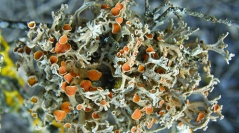

 Cryptogamie, Algologie
43 (9) - Pages 135-145
Cryptogamie, Algologie
43 (9) - Pages 135-145Coccoid microalgae of the genus Trebouxia Puymaly are by far the most prevalent among the various species involved in lichen symbioses. However, their taxonomic knowledge is rather scarce compared to that of lichenized fungi. In the present work, a taxonomic study integrating diverse techniques (phylogenetics, light, confocal and transmission electron microscopies) is carried out to describe Trebouxia maresiae Garrido-Benavent, Chiva & Barreno, sp. nov. This species widely associates with the red-listed lichenized fungus Seirophora villosa (Ach.) Frödén but also with species of the genus Ramalina Ach., both occurring in coastal environments in the western Mediterranean and the Cape Verdean islands. This microalga is circumscribed to Trebouxia clade A and is closely related to T. decolorans Ahmadjian. It is characterized by the cell size being up to 15 µm in diam., the crenulate chloroplasts, and the structure of pyrenoids, which in cultured cells fits well with the crenulata-type, with long branched tubules meandering through the pyrenoid matrix, whereas in the lichenized state it acquires a hybrid structure (maresiae-type), characterized by the periphery of the pyrenoid being rather gigantea-type, with thylakoid membranes forming short, branched tubules. With the present work, the taxonomy of the genus Trebouxia moves a step forward towards more accurately characterizing species in lichen microalgae which is a prerequisite for future, more complex studies on speciation, co-evolution and selectivity.
Mediterranean, Cape Verde, lichen, photobiont, symbiosis, new species